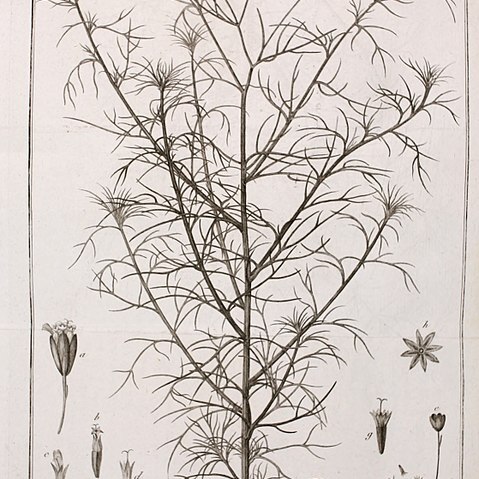Annual herb, 0.15-0.60 m high; much branched, sparsely glandular-pubescent. Leaves alternate, sessile, dissected, segments narrow, margins entire. Capitula radiate or discoid, several flowered, on long peduncles, terminal and axillary; involucre turbinate or campanulate; bracts in 1-3 rows. Receptacle epaleate. Ray florets when present, female, fertile; corolla yellow, strap-shaped; style branches linear, obtuse. Disc florets bisexual, fertile; corolla yellow or tinged reddish, tubular below, campanulate above, 5-toothed. Anthers with base and apical appendage both obtuse; style branches linear, apex rotundate-truncate or shortly appendaged. Flowering time (July) Dec.-Apr. Pappus of 8-10 scales, midrib prominent. Cypselae narrowly obpyramidal, 4-angled.
Annual herb to 60 cm high. Stems with sparse eglandular hairs. Leaves (or leaf segments) thread-like, 8–25 mm long, 0.3–0.5 mm wide, sparsely hispid, glandular-punctate; lower leaves pinnately divided with 5–9 segments; upper leaves reduced and often simple. Capitula mostly terminal; involucre obconical, 1.5–3.5 mm diam. at anthesis; involucral bracts 4 or 5, broadly elliptic, 4.5–5.5 mm long, obtuse; 2 accessory bracts present, c. half length of involucral bracts. Ray floret 1 or absent. Disc florets 4 or 5; tube 1.4–1.8 mm long, glandular; lobes deltate, 0.3–0.4 mm long, glabrous; anthers 0.5–0.6 mm long. Achenes 3.2–4.5 mm long, black to brown. Pappus scales 0.7–2.3 mm long, all ±equal or some longer, shortly awned.
Annual herb 5-50 cm high; much branched, the branches glandular and pilose. Leaves alternate, pinnatisect or the upper simple and filiform, in outline 1-6 cm long, 0.1-2 cm wide, with 3-7 lobes, these filiform or themselves divided, pilose or glabrous, glandular. Capitula turbinate or ovoid, on stalks to 3.5 cm long; involucre 4.5-6 mm long; phyllaries 2-6 mm long with yellow apex, glandular. Ray floret 1, sometimes absent, yellow, 1-2 mm long, glandular; disc florets 4-8, 2 mm long with glandular lobes. Achenes black, 3-4.5 mm long, ribbed, hairy; pappus scales 8, pale brown with purple marks or purplish, lanceolate, 1-2.5 mm long, hairy.
Annual herb, up to 0.6 m high. Stems ribbed with small, clavate glands on ribs. Leaves alternate; blade pinnately dissected, lobes filiform, glandular-punctate. Heads minutely radiate, on long, filiform peduncles, terminal and axillary, in corymbose panicles. Involucre turbinate; involucral bracts few, 5-8, glistening glandular-punctate. Flowers: 1 ray floret per head, ray and disc florets yellow; Aug., Nov.-Apr. Fruit with cypsela narrowly turbinate, 4-angled, appressed-hairy on angles. Pappus of small scales.
An annual herb. It can grow 60 cm high. The leaves are alternate and have leaflets along the stalk. The flowers are in heads in loose groups. They are yellow. The fruit have 4-5 angles.

